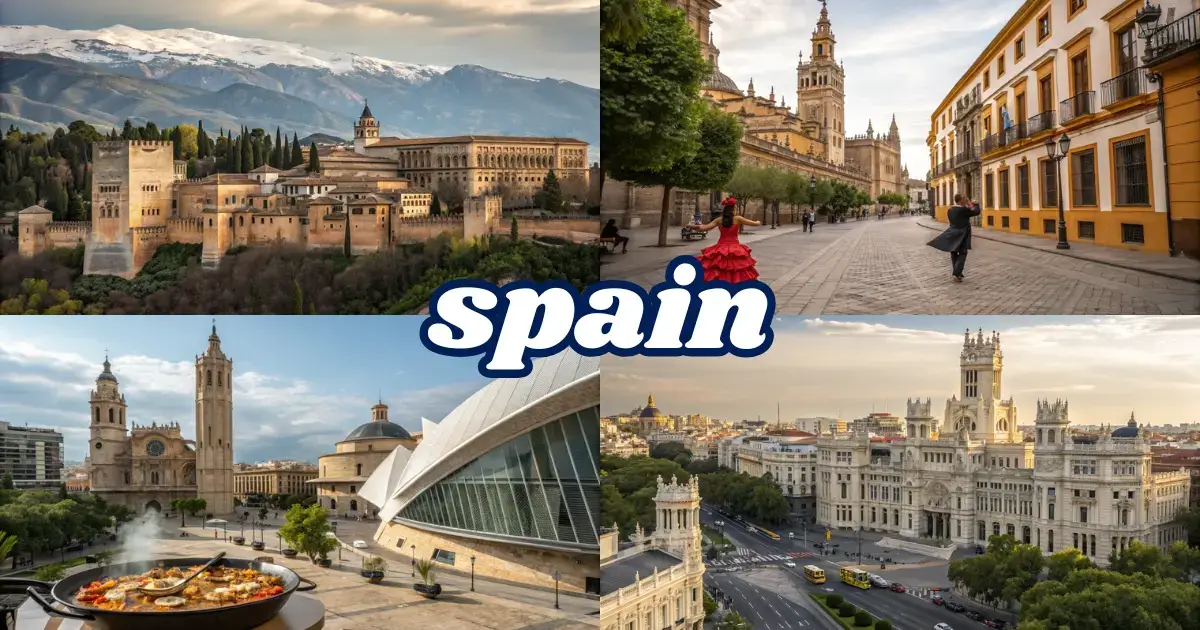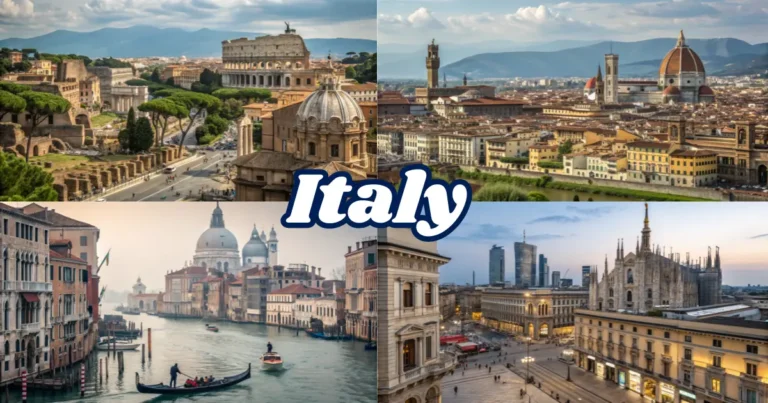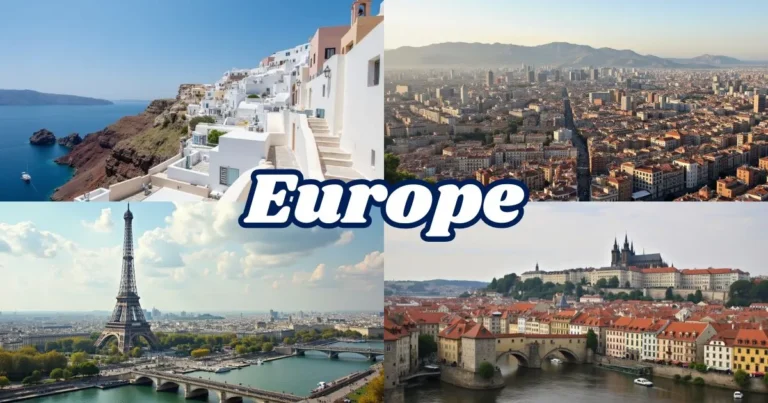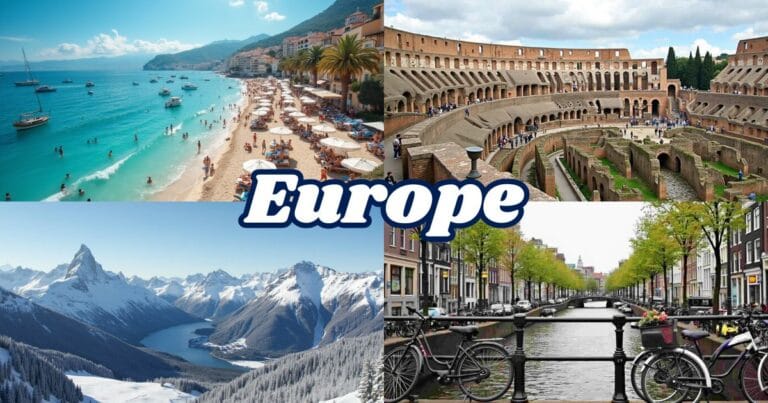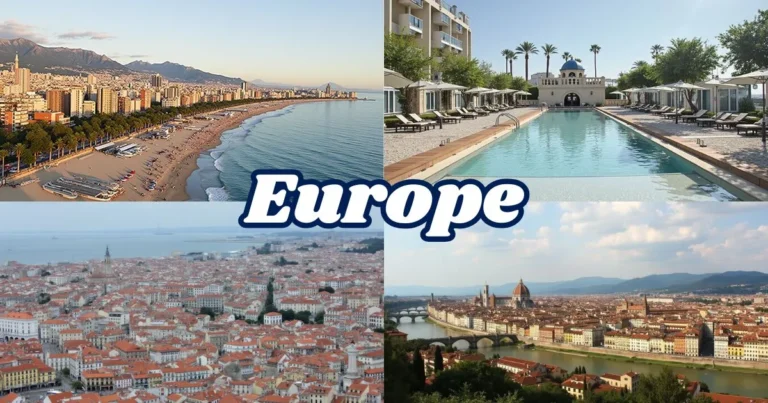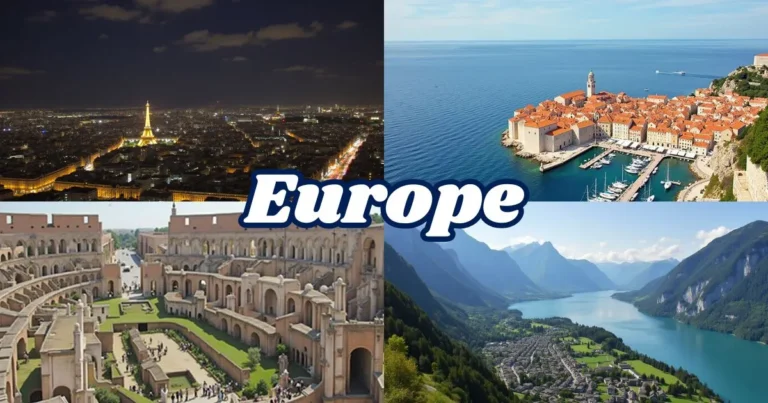Discover the Best Cities in Spain for an Unforgettable Getaway
Table of Contents
Best cities in spain
Are you ready to explore the best cities in Spain? This amazing country is full of rich culture, deep history, and vibrant urban life. Whether you’re drawn to the artistic masterpieces of Madrid or the architectural wonders of Barcelona, the best cities in Spain to visit offer unforgettable experiences for every type of traveler.
Traveling through Spain isn’t just about seeing landmarks — it’s about diving into local traditions, enjoying delicious food, and discovering hidden gems that make each place special. The best cities to go in Spain combine iconic sights with unique character and charm.
Planning your trip is easy when you know where to go. Whether you’re seeking romance, family fun, or solo adventure, the best cities to visit in Spain promise something for everyone. From north to south, each stop on your journey will show you why these are truly the Spain best cities to visit.
Key Takeaways
- The best cities in Spain offer a wide variety of experiences, from art and history to food and beaches.
- Madrid and Barcelona are essential stops for culture and architecture lovers.
- Exploring beyond major landmarks reveals the heart of Spanish city life.
- Every destination on your list of the best cities in Spain to visit has something unique and unforgettable.
Spain: A Tapestry of Culture, History, and Vibrant City Life
Spain’s cities are a mix of Moorish palaces and modern architecture. You’ll find a rich history, art, and lively city life. Exploring these places is a unique experience.
What Makes Spanish Cities Unique
Spanish cities blend old and new in a special way. You can see the Alhambra in Granada or the City of Arts and Sciences in Valencia. They are also known for flamenco music and dance, adding to their culture.
- Rich historical heritage with landmarks like the Alhambra and Mezquita
- Vibrant cultural festivals, including La Tomatina and Semana Santa
- World-class museums and art galleries, such as the Prado and Guggenheim
When to Visit Spain’s Urban Centers
The best time to visit Spain’s cities varies. Spring (March to May) and autumn (September to November) offer nice weather and fewer people. Summer is hot, especially in the south, but great for beaches. Winters are mild, perfect for cultural attractions without crowds.
Some key events to consider when planning your trip include:
- La Tomatina festival in Buñol (August)
- Semana Santa (Holy Week) in cities like Seville and Málaga
- Feria de Abril in Seville (April)
Barcelona: The Modernist Marvel of Catalonia
When you arrive in Barcelona, you’re surrounded by amazing architecture and culture. This city is famous for its modernist buildings, beautiful beaches, and vibrant culture. It’s one of the best cities to visit in Spain.
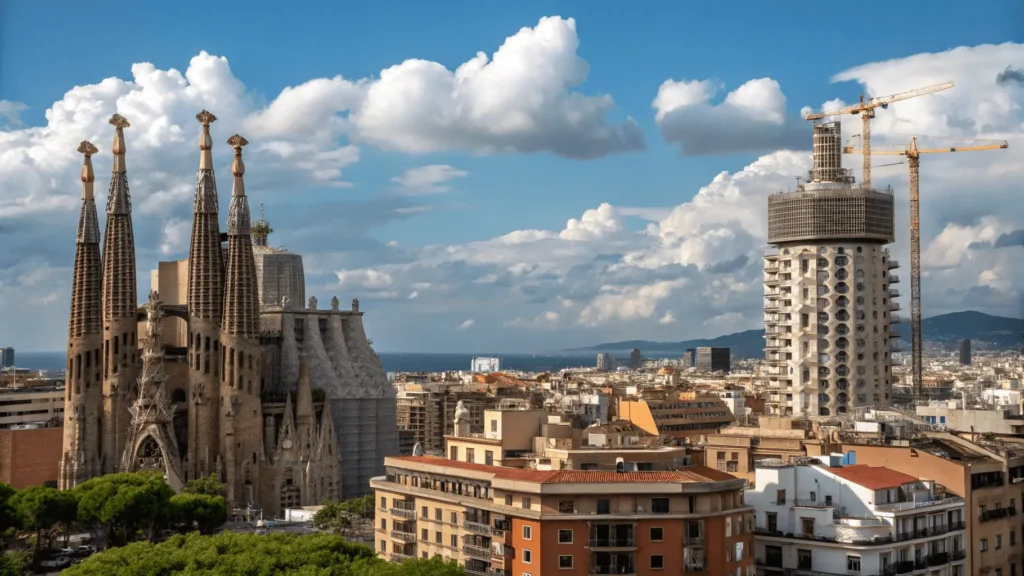
Gaudí’s Architectural Wonders
Barcelona is all about Antoni Gaudí’s unique designs. You can see his famous works like the Sagrada Familia, Park Güell, and Casa Batlló.
Sagrada Familia: Spain’s Most Iconic Landmark
The Sagrada Familia is Gaudí’s masterpiece. It’s a huge cathedral that’s been built for over a century. Its tall spires and detailed stone carvings show Gaudí’s creative style.
Park Güell and Casa Batlló
Park Güell is a stunning outdoor space with colorful mosaics and stone columns. Casa Batlló has a bright façade and quirky details. Both show Gaudí’s talent in making buildings into art.
Las Ramblas and Gothic Quarter Exploration
Barcelona has more than Gaudí’s buildings. Las Ramblas is a lively street with street performers, cafes, and shops. The Gothic Quarter is a maze of old streets and buildings, showing the city’s medieval history.
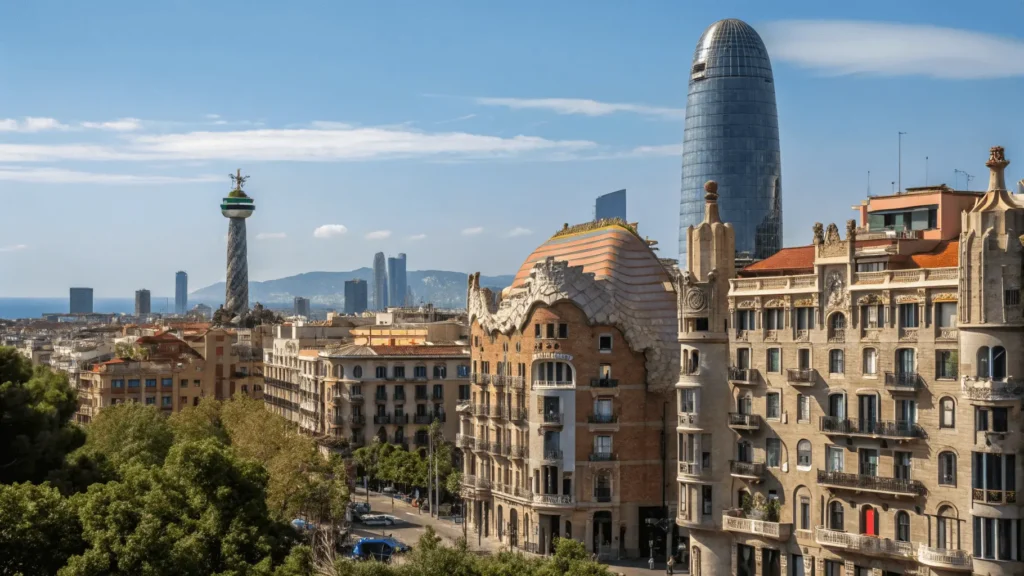
Barcelona’s Beach Culture and Seafront
Barcelona’s beaches, like Barceloneta and Nova Icària, are great for relaxing. The seafront promenade has restaurants and bars for a stroll or dinner. Barcelona mixes city life with beach charm, making it a top spot for Catalonia travel.
| Attraction | Description | Must-See Features |
| Sagrada Familia | Iconic cathedral designed by Antoni Gaudí | Towering spires, intricate stone carvings |
| Park Güell | Public park featuring Gaudí’s unique design | Mosaic benches, twisting stone columns |
| Las Ramblas | Bustling pedestrian street | Street performers, cafes, shops |
| Barceloneta Beach | Popular urban beach | Relaxing atmosphere, seafront promenade |
Madrid: The Regal Capital with Artistic Soul
When you arrive in Madrid, you’re surrounded by its deep history and lively culture. This city is full of artistic and architectural wonders. From ancient landmarks to modern art, there’s something for everyone.
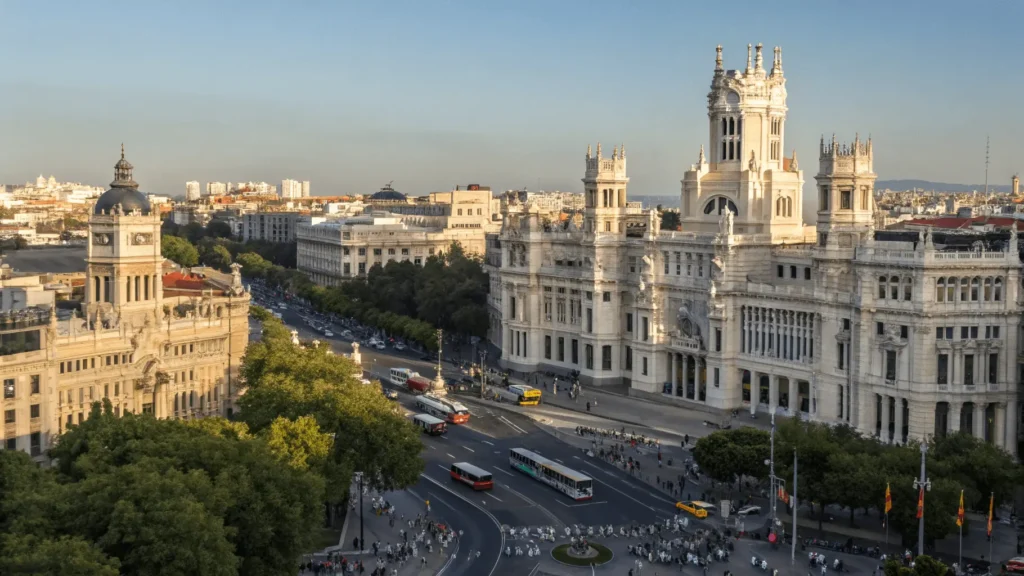
Royal Palace and Plaza Mayor
The Royal Palace in Madrid is where the Spanish royal family lives, but they mostly use it for special events. Next to it, Plaza Mayor has been the center of Madrid’s social life for ages.
The Golden Triangle of Art
Madrid is famous for its Golden Triangle of Art. It includes the Prado, Reina Sofía, and Thyssen-Bornemisza museums. These museums offer an amazing art experience, covering art from the 12th to the 20th century.
Prado Museum Highlights
The Prado Museum has a huge collection of European art. You can see works by Goya, Velázquez, and El Greco. Don’t miss Goya’s “The Third of May 1808” and Velázquez’s “Las Meninas.”
Reina Sofía and Thyssen-Bornemisza
The Reina Sofía Museum focuses on modern art, with pieces by Picasso, Dalí, and Miró. The Thyssen-Bornemisza Museum fills in the gaps in the Prado and Reina Sofía collections. Together, they give a full view of Western art.
Madrid’s Legendary Nightlife and Culinary Scene
Madrid is known for its lively nightlife. You can find bars, clubs, and flamenco shows everywhere. The city’s food scene is also amazing, with both traditional and modern restaurants serving tasty tapas and local dishes.
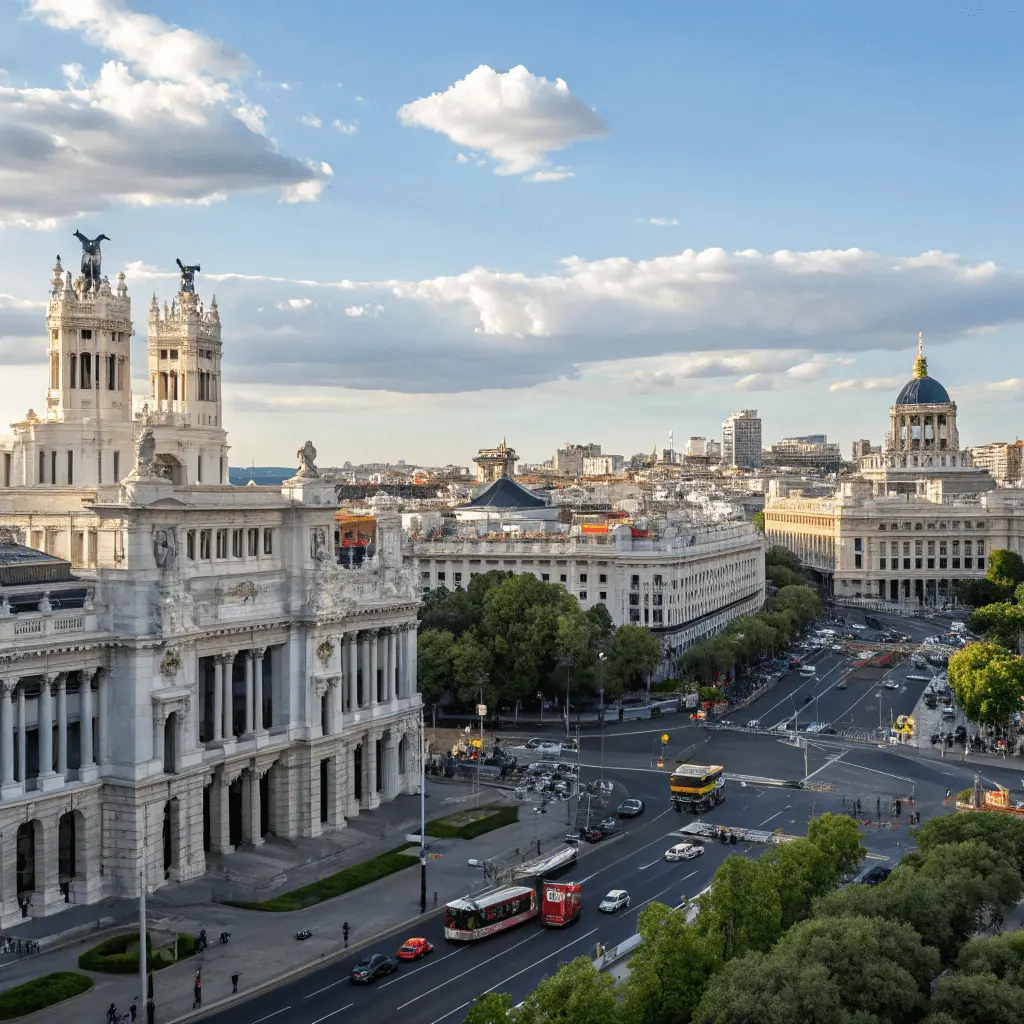
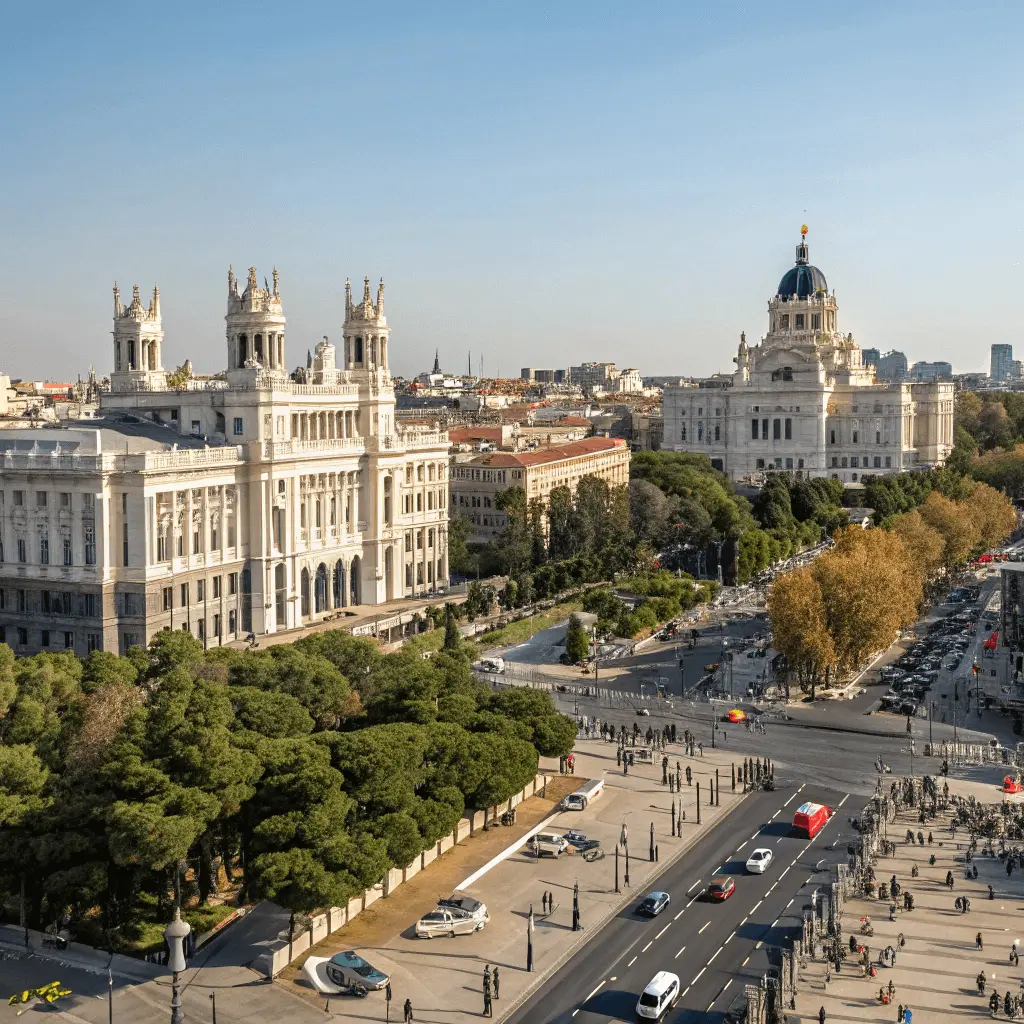
| Attraction | Location | Opening Hours |
| Royal Palace | Plaza de la Armería, s/n | 10:00 AM – 6:00 PM |
| Prado Museum | Calle de Felipe IV, s/n | 10:00 AM – 8:00 PM |
| Reina Sofía Museum | Calle de Santa Isabel, 52 | 10:00 AM – 9:00 PM |
Seville: Andalusia’s Flamenco-Infused Gem
Walking through Seville’s streets, you feel Andalusia’s lively spirit. This city is famous for its flamenco, historic sites, and friendly people.
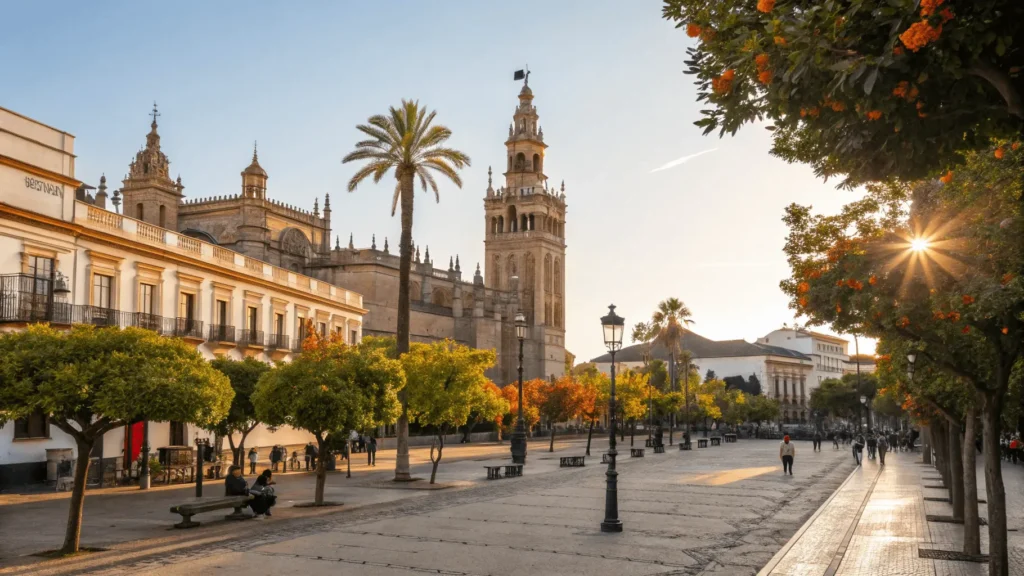
The Alcázar and Cathedral
The Alcázar Palace shows off Mudéjar architecture with its detailed tiles and peaceful gardens. Next to it, the Seville Cathedral is impressive, with the Giralda Tower giving amazing views of the city.
Barrio Santa Cruz and Plaza de España
Exploring Barrio Santa Cruz’s narrow streets is a must. You’ll find cute shops and lovely plazas. Plaza de España is also a must-see, with its beautiful tiles and calm canals.
Authentic Flamenco Experiences
Seville is the center of flamenco. Seeing this intense dance is a must. You can enjoy intimate tablao shows or street performances, both are captivating.
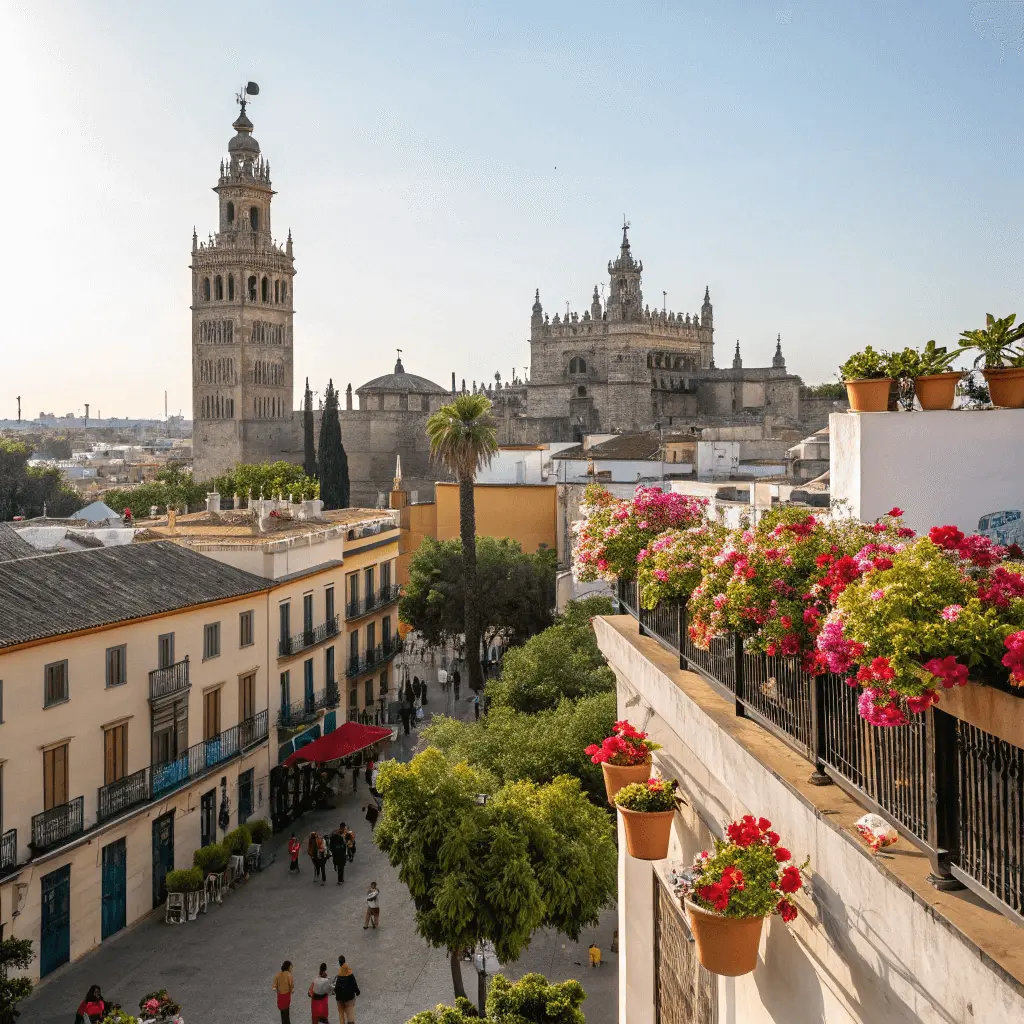
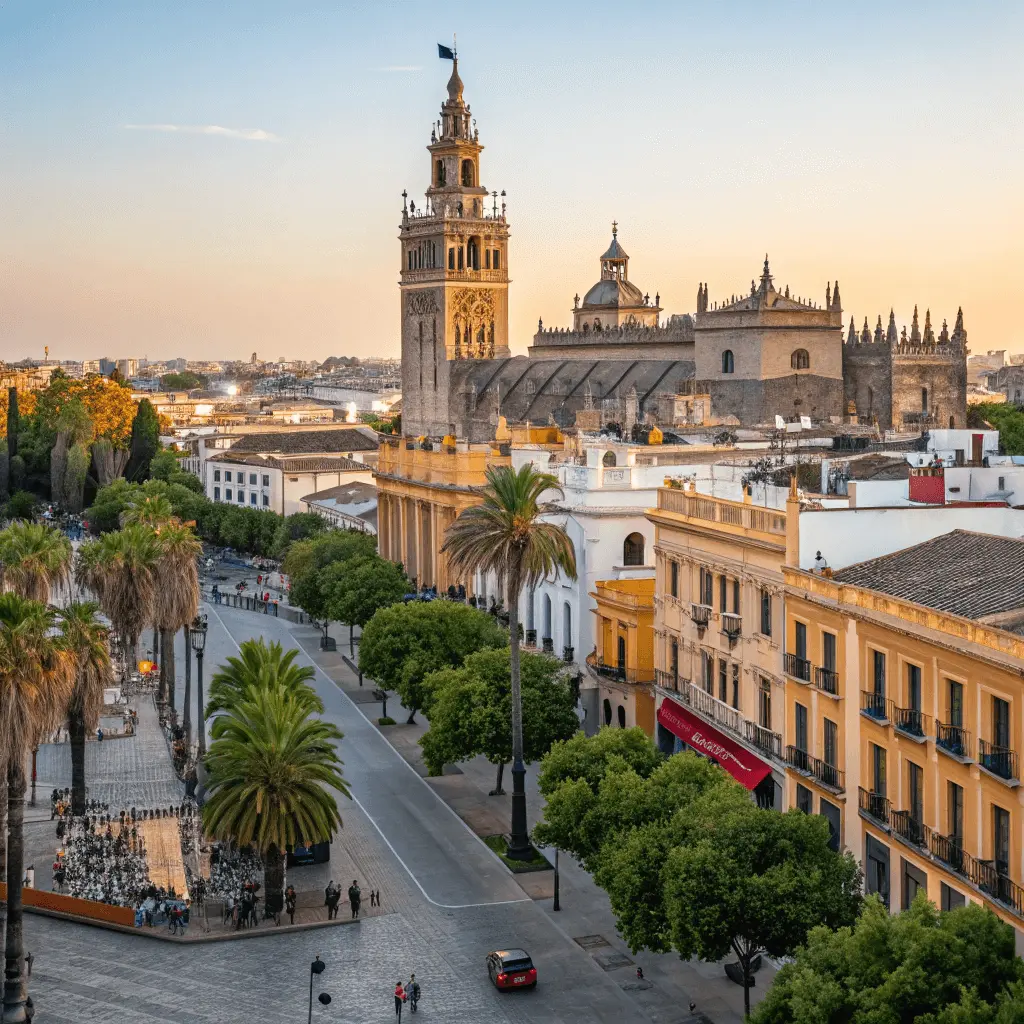
| Experience | Location | Price Range |
| Flamenco Show | Tablao Cordobés | $20-$50 |
| Guided Tour of Alcázar | Alcázar Palace | $10-$20 |
| Tapas Tour | Barrio Santa Cruz | $30-$60 |
Seville offers a unique travel experience with its rich culture and flamenco. You can visit historic sites, enjoy flamenco, or just enjoy the city’s vibe. Seville will surely make a lasting impression on you.
Valencia: Where Tradition Meets Futuristic Design
Valencia sits on Spain’s southeastern coast, blending history with modern architecture. This vibrant city offers a mix of modern sights and timeless traditions. It’s a top spot to visit in Spain.
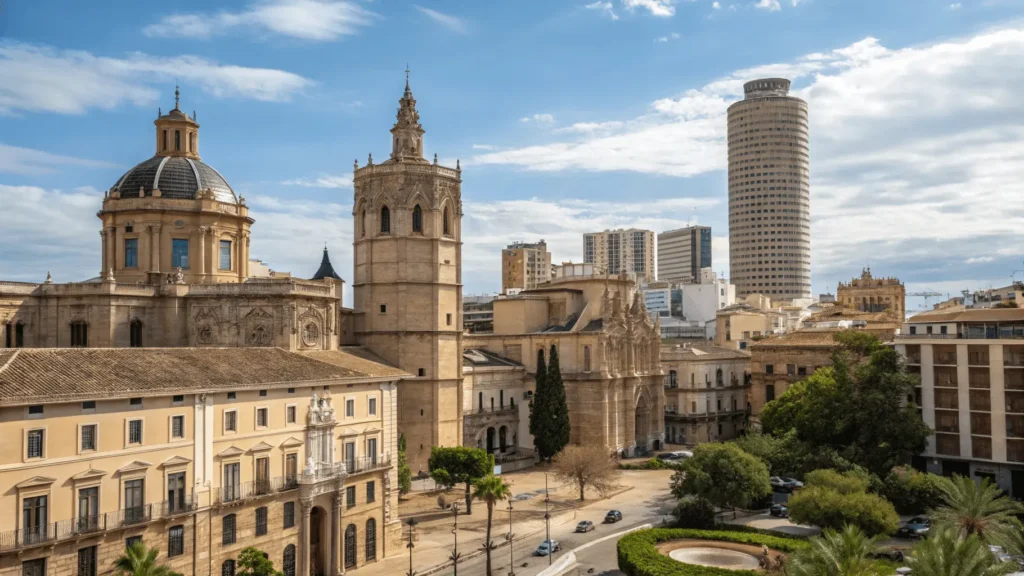
City of Arts and Sciences
The City of Arts and Sciences is Valencia’s iconic landmark. It features attractions like the L’Hemisfèric (a 3D cinema), El Palau de les Arts Reina Sofia (an opera house), and El Museu de les Ciències Príncep Felipe (a science museum). Spend a day here to see these innovative structures and enjoy the gardens and waterways.
Historic Old Town Treasures
Valencia’s historic old town is full of charm. The Central Market is a highlight, with its vibrant displays of fresh produce and local treats. Don’t miss the Silk Exchange (La Lonja de la Seda), a UNESCO World Heritage Site, and the Valencia Cathedral, known for its Gothic and Baroque styles.
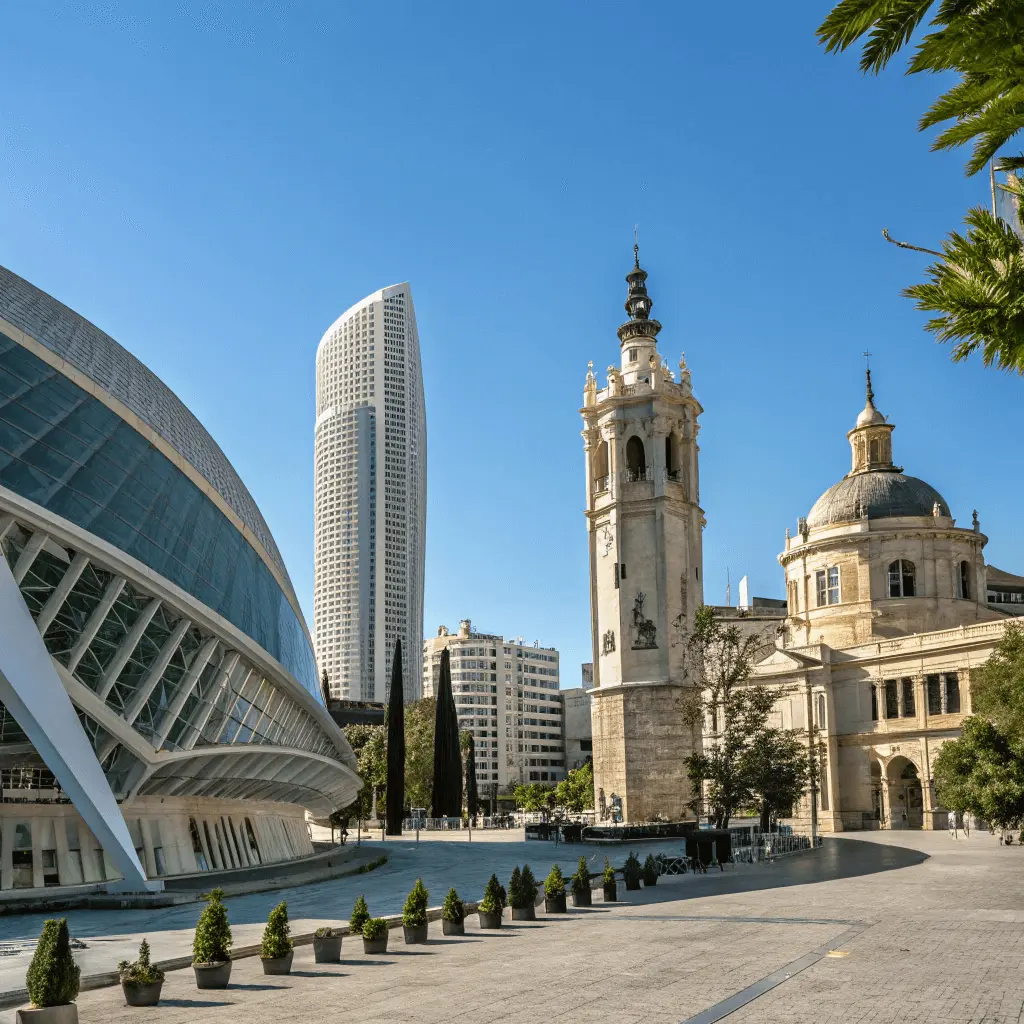
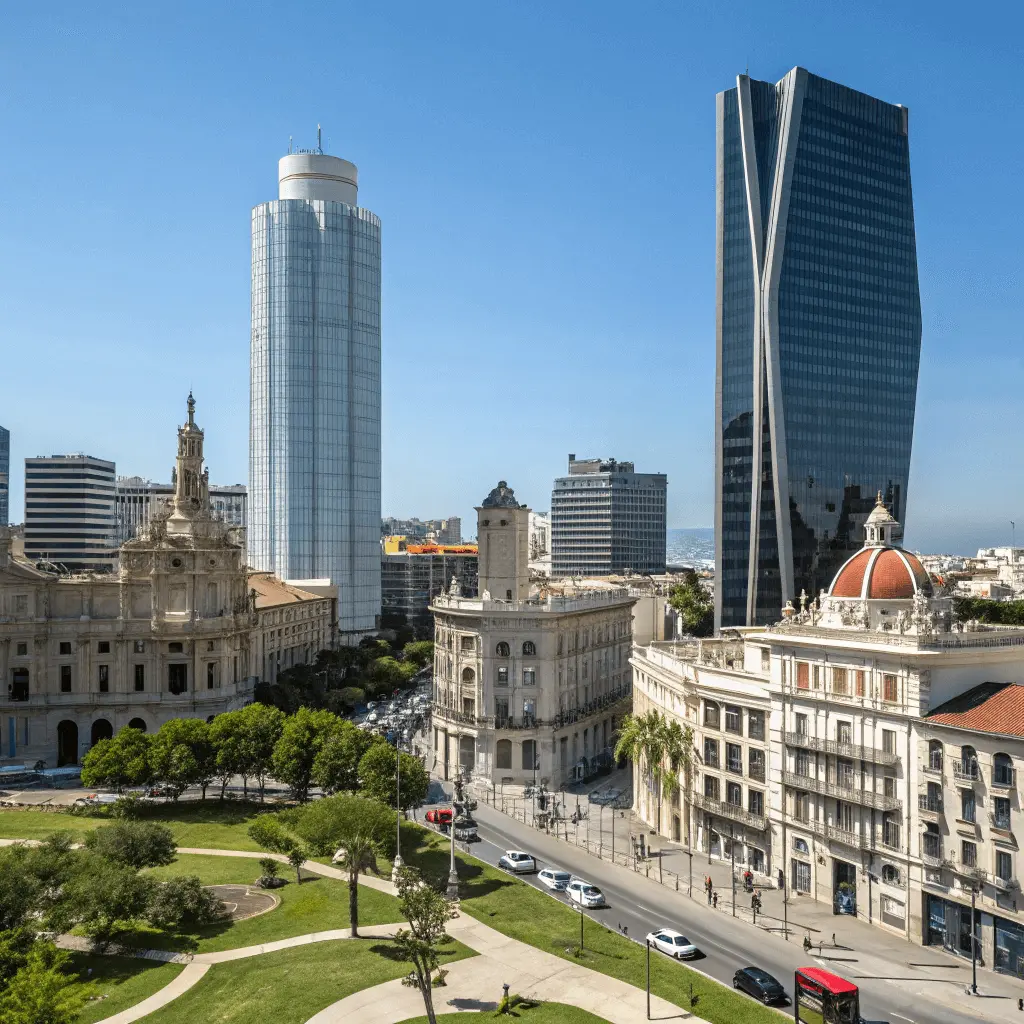
The Birthplace of Paella and Food Culture
Valencia is famous for being the birthplace of paella. Try authentic paella valenciana at local spots like El Perelló and La Albufera. The city’s food scene focuses on fresh veggies, seafood, and local wines. Exploring local cuisine is key to experiencing Valencia’s rich food heritage.
Granada: Moorish Splendor in the Sierra Nevada
Granada sits in the Sierra Nevada mountains, showing the heart of Moorish Spain. You’ll find a mix of history, culture, and stunning architecture as you explore.
The Magnificent Alhambra
The Alhambra is Granada’s gem, a Moorish palace known worldwide for its beauty. It shows the city’s deep history and cultural richness.
Nasrid Palaces
The Nasrid Palaces in the Alhambra are a must-see. They’re filled with Islamic art and architecture. Walking through, you’ll see the stucco work and feel the calm of the courtyards.
Generalife Gardens
Next to the Alhambra, the Generalife Gardens are a peaceful spot. They have greenery, fountains, and views of the Alhambra. It’s the perfect place to unwind and enjoy Granada’s beauty.
Albaicín and Sacromonte Districts
Granada’s Albaicín and Sacromonte districts are also worth a visit. Albaicín’s streets are filled with shops and restaurants. Sacromonte is famous for its flamenco music and dance. Here, you can truly experience Granada’s culture.
Granada’s Free Tapas Culture
Granada is known for its free tapas tradition. When you have a drink at a bar, you get a free tapas dish. It’s a great way to try local food and feel Granada’s hospitality.
In short, Granada is a city that combines history, culture, and beauty. From the Alhambra to the neighborhoods and tapas, it has something for everyone.
San Sebastián: Culinary Capital on the Cantabrian Coast
Walking through San Sebastián’s streets, you’ll see why it’s Spain’s food capital. This beautiful city by the Cantabrian Coast is famous for its food. It mixes traditional Basque dishes with new culinary ideas.
Pintxos Crawl Through Old Town
Exploring San Sebastián’s old town is a must. Here, you’ll find pintxos, the Basque version of tapas. These small dishes are found in bars and restaurants. You’ll taste everything from classic anchovies to new creations.
Some top places for pintxos include:
- Bar El Puerto, known for its delicious pintxos and lively atmosphere.
- Bar Zeruko, offering creative pintxos with a focus on local produce.
- Bar Borda Berri, a favorite among locals for its traditional Basque pintxos.
La Concha Beach and Bay
San Sebastián is more than food; it has the stunning La Concha Beach. This beach is one of Europe’s most beautiful. The bay, surrounded by hills, is perfect for walks or sunbathing.
Visitors can enjoy water sports, take boat tours, or just relax on the sand.
Michelin-Starred Dining Experiences
For a fancy meal, San Sebastián has many Michelin-starred restaurants. These places offer top-notch dining. They show off Basque cuisine with a modern twist. Some highlights include:
- Moko, a three-Michelin-starred restaurant known for its innovative and artistic dishes.
- Arzak, a legendary restaurant with three Michelin stars. It combines tradition and innovation.
- Mugaritz, a two-Michelin-starred restaurant famous for its creative and seasonal menus.
San Sebastián’s food scene is a mix of tradition and innovation. Whether you try pintxos, dine at a Michelin-starred place, or enjoy La Concha Bay, it’s unforgettable.
Málaga: Picasso’s Birthplace and Costa del Sol Gateway
Málaga is a city that blends old traditions with modern life. It’s located on the sunny Costa del Sol. Here, you’ll find a mix of culture, history, and great food.
Picasso Museum and Artistic Heritage
Pablo Picasso, a famous artist, was born in Málaga. The Picasso Museum has many of his works. It shows how he grew as an artist. You can also see Picasso’s Birthplace in the old town.
- Discover over 200 works by Picasso at the Picasso Museum.
- Visit the house where Picasso was born.
- Explore the city’s artistic heritage through its numerous galleries.
Alcazaba and Roman Theater
The Alcazaba and Roman Theater show Málaga’s rich history. The Alcazaba is a Moorish fortress with great views. The Roman Theater is a piece of Málaga’s ancient times.
- Explore the Alcazaba’s gardens and enjoy panoramic views.
- Visit the Roman Theater, a well-preserved archaeological site.
Málaga’s Emerging Food Scene and Beachfront
Málaga’s food scene is lively and diverse. You can try traditional Andalusian dishes or new fusion foods. Along Malagueta Beach, there are many places to eat fresh seafood.
- Enjoy fresh seafood at one of the many beachfront restaurants.
- Explore the local markets for authentic Andalusian cuisine.
Málaga offers a lot to see and do. It’s perfect for starting your Spanish journey. With its art, history, and food, Málaga is unforgettable.
Toledo: The Medieval City of Three Cultures
Toledo sits in Spain’s heart, blending its medieval past with a lively cultural scene. As you wander this ancient city, you’ll find a mix of historical sites and cultural influences.
El Greco’s Legacy
El Greco, a famous artist, found inspiration in Toledo. His workshop, now a museum, displays some of his best works. El Greco’s art, a mix of Byzantine and Renaissance styles, shows Toledo’s rich cultural mix.
Cathedral and Jewish Quarter
The city’s Cathedral, a Gothic marvel, stands next to the historic Jewish Quarter. Here, you can walk narrow streets and see the Sinagoga del Tránsito. This synagogue, from the 14th century, is a prime example of Mudéjar architecture.
Panoramic Views from the Alcázar
For stunning views of Toledo, visit the Alcázar. This former royal palace and military school sits on a hill. It offers panoramic views of the city and the Tagus River, giving a unique look at Toledo’s medieval design.
Some top sights in Toledo include:
- The historic center, a UNESCO World Heritage Site
- El Greco’s workshop and museum
- The Gothic Cathedral and its stunning stained-glass windows
- The Sinagoga del Tránsito and the Jewish Quarter
- The Alcázar and its panoramic views
Bilbao: Industrial Port Turned Cultural Powerhouse
Bilbao is a city that has merged its industrial past with modern culture. It was once a bustling industrial port. Now, it’s a vibrant cultural scene.
The Revolutionary Guggenheim Museum
The Guggenheim Museum shows Bilbao’s cultural rebirth. Designed by Frank Gehry, it’s a symbol of the city’s innovative spirit. Its flowing curves and titanium cladding make it a masterpiece.
It houses a vast collection of contemporary and modern art. This makes it a top attraction.
Casco Viejo (Old Quarter) Exploration
Bilbao’s Casco Viejo or Old Quarter reveals its rich history. This area has narrow streets, charming plazas, and ancient buildings.
Explore the Plaza Nueva, the Calle del Perro with its lively bars, and the Bilbao Cathedral, a stunning Gothic church. The Casco Viejo is ideal for experiencing local culture and food. It shows the city’s industrial past in a new way.
Córdoba: Home to the Mesmerizing Mezquita
As you explore Córdoba’s historic streets, you’ll find a city rich in culture. It boasts many architectural and historical gems. But none shine as brightly as the Mezquita.
The Mezquita in Córdoba showcases the city’s Islamic past. It was a key site in the Islamic world during the Middle Ages. Its architecture combines Moorish and Gothic styles, reflecting Córdoba’s complex history.
The Mosque-Cathedral Wonder
The Mezquita is a breathtaking sight with over 850 columns. These columns create a forest of red and white stone arches. This iconic monument is more than a mosque or cathedral. It symbolizes Córdoba’s deep history and cultural wealth.
Jewish Quarter and Flower-Filled Patios
Córdoba’s Jewish Quarter offers a peek into the city’s diverse heritage. Its narrow streets and historic buildings are a sight to behold. The area is also famous for its beautiful patios bursting with flowers.
The annual Córdoba Patio Festival celebrates this tradition. It draws visitors from all over the world.
Visiting Córdoba is like entering a living museum. Every corner has a story of the city’s past. From the Mezquita’s grandeur to the flower-filled patios, Córdoba will captivate you. It will leave you with memories you’ll always treasure.
Best Cities in Spain for Different Travel Styles
Spain has something for everyone, whether you love architecture, food, or nightlife. Each city offers a unique experience, making it easy to find the perfect place to visit.
For History Buffs and Architecture Enthusiasts
Spain is filled with cities rich in history and stunning architecture. Toledo is a top choice for history lovers, with its medieval old town. The Cathedral of Toledo and the Alcázar showcase its past.
Granada’s Alhambra is a must-see for its Moorish beauty. Barcelona’s Gothic Quarter and Gaudí’s Sagrada Família draw architecture fans from everywhere.
For Food and Wine Connoisseurs
Cities like San Sebastián and Valencia are food lovers’ dream destinations. San Sebastián is famous for its pintxos, small but flavorful tapas. Valencia is where paella originated, offering many authentic versions.
Wine lovers will enjoy the Ribeiro and Priorat regions. These areas are known for their excellent wines.
For Beach Lovers and Nightlife Seekers
Barcelona and Madrid are ideal for those who love the beach and nightlife. Barcelona’s Barceloneta beach is great for sunbathing. Madrid’s Malasaña and Chueca areas are known for their lively nightlife.
Málaga offers beautiful beaches and a rich culture, perfect for a relaxing beach trip.
Practical Tips for American Travelers Visiting Spanish Cities
Spain is a top pick for American travelers, thanks to its rich culture and lively cities. Knowing the local ways, from language to tipping, can make your trip better.
Language, Currency, and Tipping Customs
Many Spaniards speak some English, but learning basic Spanish is helpful. The Euro is the currency, and credit cards are widely used. Tipping is less common than in the U.S., with rounding up or leaving 5-10% seen as polite.
- Learn basic Spanish to interact with locals.
- Have some cash on hand, though credit cards are widely accepted.
- Understand that tipping culture is more subdued than in the U.S.
Safety and Health Considerations
Spain is generally safe, but watch out for petty theft in tourist spots. Stay current with vaccinations and protect yourself and your stuff.
Be mindful of your belongings, especially in crowded areas.
Adapting to Spanish Schedules and Customs
Spain’s late lunches and dinners are a big part of its culture. Getting into this rhythm can make your trip more enjoyable.
Adjust your meal times to align with local customs.
Getting Around: Transportation Between Spanish Cities
Exploring Spain’s cities is now easier than ever. You can travel between coastal cities or explore the interior. Spain’s transportation network makes your journey smooth and efficient.
Spain’s Efficient Train Network
Spain’s train network is top-notch, with high-speed trains connecting major cities. The AVE trains can go up to 310 km/h (193 mph). This cuts travel time between cities a lot.
For example, Madrid to Barcelona is just over 3 hours by train. You can book tickets on the Renfe website or mobile app.
Here’s a quick look at travel times between major cities by train:
| Route | Travel Time |
| Madrid to Barcelona | 3 hours |
| Madrid to Seville | 2.5 hours |
| Barcelona to Valencia | 3 hours |
Domestic Flights and Bus Options
For longer trips, Spain’s domestic flights are a good choice. Airlines like Iberia, Vueling, and Ryanair offer many flights. But, flying can take longer due to check-in and security.
Bus travel is also affordable. Companies like ALSA cover many routes. It’s a good way to see the countryside and reach city centers directly.
Car Rental Tips for Spain
Renting a car lets you explore Spain’s scenic routes at your pace. Companies like Europcar, Avis, and Sixt have desks at airports and city centers. But, driving in historic city centers can be tough due to narrow streets and limited parking.
“Renting a car in Spain is a great way to explore the countryside and discover hidden gems off the beaten path.”
— Travel Spain Magazine
Make sure you have the right documents when renting a car. You’ll need a valid driver’s license and insurance. Also, check the car’s condition before you leave the rental lot.
Planning Your Spanish Cities Itinerary
Spain has many amazing cities to see, making it key to plan well for a great trip. Its cities are full of culture, history, and life. Planning your trip here can be both fun and challenging.
We’ve put together some itinerary ideas for different interests and time frames. Whether you want a quick visit or a deep dive, these suggestions will help you plan a trip that fits your style.
One-Week Spain Highlights Tour
For those short on time, a one-week trip can cover Madrid, Barcelona, and Seville. Start in Madrid to see its art and history. Next, head to Barcelona for Gaudí’s Sagrada Família and La Rambla. End in Seville to enjoy its Santa Cruz neighborhood and the Cathedral.
Two-Week Comprehensive Spanish Cities Journey
With two weeks, you can explore more of Spain. Visit Madrid, Barcelona, and Seville first. Then, go to Valencia for the City of Arts and Sciences, Granada for the Alhambra, and San Sebastián for its pintxos. This trip offers a full taste of Spain’s cities.
Regional Focus Trips
Spain is great for regional trips too. You could explore Andalusia, visiting Córdoba, Málaga, and Cádiz. Or, head north to Bilbao, Santiago de Compostela, and the Basque Country. Focusing on one area lets you really get to know Spain’s culture and landscapes.
| City | Main Attractions | Best Time to Visit |
| Madrid | Royal Palace, Prado Museum | Spring or Fall |
| Barcelona | Sagrada Família, Park Güell | Summer for Beach Activities |
| Seville | Cathedral, Alcázar | Spring for Festivals |
Conclusion: Your Spanish Urban Adventure Awaits
Spain is a country that effortlessly combines ancient history with modern charm. Whether you’re drawn to the surreal designs of Gaudí in Barcelona, the royal elegance of Madrid, or the flamenco rhythms of Seville, each city brings something unique. From coastal getaways to mountain hideaways, the best cities in Spain offer a blend of culture, food, and unforgettable experiences.
Planning your itinerary around the best cities to visit in Spain ensures you’ll enjoy both famous landmarks and hidden gems. Whether you’re searching for romance, adventure, or family fun, you’ll find that the Spain best cities to visit are filled with life and inspiration. No matter where you go, the best cities to go in Spain promise lasting memories and stories worth sharing.
Get ready to explore, savor, and fall in love with the best cities in Spain to visit — your unforgettable journey awaits.
FAQ: Exploring the Best Cities in Spain
What are the best cities in Spain to visit for first-time travelers?
For first-time visitors, the best cities in Spain include Madrid, Barcelona, Seville, Valencia, and Granada. These cities offer a mix of history, culture, food, and vibrant city life. Each one gives you a different view of Spanish heritage and lifestyle.
Which are the best cities to go in Spain for food lovers?
If food is a priority, the best cities to go in Spain include San Sebastián (famous for pintxos and Michelin-starred dining), Valencia (home of authentic paella), Barcelona, and Málaga for their mix of traditional and modern cuisine.
What’s the best time to explore the best cities in Spain?
The best time to visit is spring (March to May) and autumn (September to November). These seasons offer pleasant weather and fewer crowds, making it ideal for exploring the best cities in Spain at a comfortable pace.
Can I visit multiple of Spain’s best cities in one trip?
Yes! Spain has an excellent train and transportation network. You can easily plan a multi-city itinerary that includes several of the Spain best cities to visit, such as Madrid, Barcelona, Seville, and Granada, even in a 1- to 2-week trip.
Are the best cities in Spain safe for tourists?
Generally, yes. The best cities in Spain to visit are safe for travelers. Like in any major city, you should watch for pickpockets in crowded areas, but violent crime is rare. Always take normal travel precautions.
What’s the easiest way to get around between the best cities in Spain?
Spain’s AVE high-speed trains are the most efficient way to travel between the best cities in Spain. You can also use domestic flights or buses, depending on your budget and schedule. Renting a car is ideal if you want to explore smaller towns along the way.
Which are the best cities in Spain for beach lovers?
For beachgoers, Barcelona, Valencia, San Sebastián, and Málaga are the top picks. These best cities in Spain to visit combine coastal charm with city excitement.

